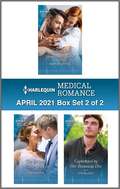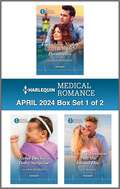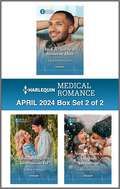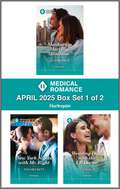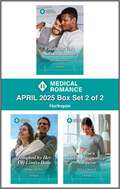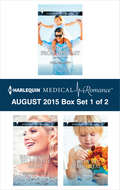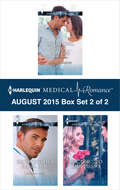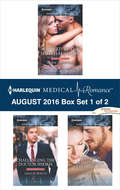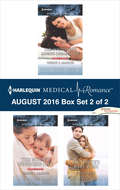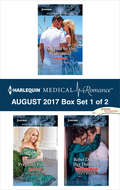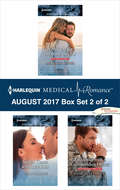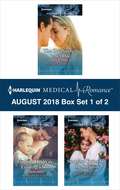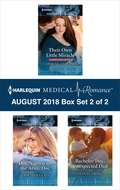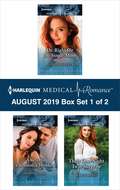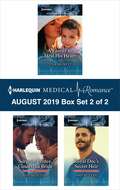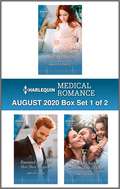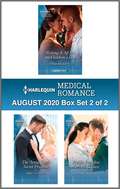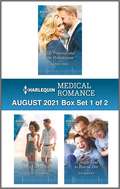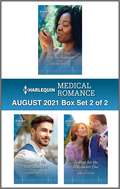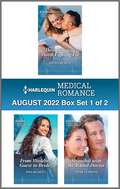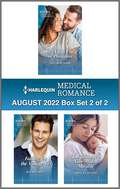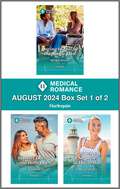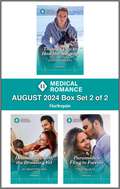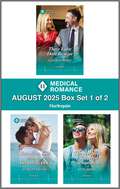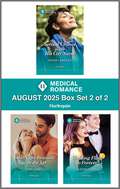- Table View
- List View
Harlequin Medical Romance April 2021 - Box Set 2 of 2
by Marion Lennox Karin Baine Sue MacKayHarlequin Medical Romance brings you a collection of three new titles, available now! Enjoy these stories packed with pulse-racing romance and heart-racing medical drama. This Harlequin Medical Romance box set includes: FALLING FOR HIS ISLAND NURSE By Marion LennoxA move to Shearwater Island is the second chance single dad Dr Angus, and his son, need. He just didn&’t count on an intense connection, with new colleague, nurse Freya!THE SURGEON AND THE PRINCESSBy Karin BaineAdjusting to life as an amputee, medic Princess Georgiana refuses help from anyone. But rehabilitation with gorgeous—off-limits—Ed means letting her guard down… Can he make her see just how strong she is?CAPTIVATED BY HER RUNAWAY DOC By Sue MacKay Helicopter Pilot Mallory&’s life is turned upside down when she finds a sexy French stranger in her house. But while passion sizzles with Josue, Mallory can&’t be sure of what&’s in his heart…
Harlequin Medical Romance April 2024 - Box Set 1 of 2
by Alison Roberts Sue MacKayHarlequin Medical Romance brings you a collection of three new titles, available now! Enjoy these stories packed with pulse-racing romance and heart-racing medical drama.This Harlequin Medical Romance box set includes:FORBIDDEN NIGHTS WITH THE PARAMEDICDaredevil DoctorsBy Alison RobertsAfter a family trauma, self-proclaimed playboy Edward is living life to the fullest. On his first day with Aberdeen-based air rescue paramedics, he&’s floored by the instant crackle of electricity he experiences with crew partner Jodie. It&’s clear heartbroken Jodie&’s not willing to risk another workplace romance, but a secret fling could be just what they need! Will forbidden nights together lead to the forever they&’ve been too scared to consider?REBEL DOCTOR&’S BABT SURPRISEDaredevil DoctorsBy Alison RobertsDr. James&’s world is turned upside down with the arrival of a stranger—nurse Sarah. Because Sarah is not alone. She&’s holding a tiny bundle—his surprise daughter! As if the situation isn&’t complicated enough, he feels an immediate connection to baby Ivy&’s beautiful guardian. And as this rebel doc opens his home—temporarily!—to this makeshift family, walking away with his heart intact soon becomes impossible…MARRIAGE REUNION WITH THE ISLAND DOC By Sue MacKayAt a destination wedding, nurse Alyssa is hoping for a stress-free break. But the best man is her ex-husband, island GP Leighton! Their whirlwind marriage collapsed as quickly as it began when Leighton suddenly withdrew from her. Alyssa never understood why, and now that they&’re stuck together for a fortnight, she wants to find out! Will her dream holiday end in closure…or a romantic reunion?
Harlequin Medical Romance April 2024 - Box Set 2 of 2
by Emily Forbes Traci Douglass Louisa HeatonHarlequin Medical Romance brings you a collection of three new titles, available now! Enjoy these stories packed with pulse-racing romance and heart-racing medical drama.This Harlequin Medical Romance box set includes:AN ER NURSE TO REDEEM HIMWyckford General HospitalBy Traci DouglassFlying EMT Tate is the new guy in town, but he won&’t be staying long. Grief and guilt keep this ex-military medic on the move. Inadvertently becoming ER nurse Madi&’s date to a charity auction should change nothing… But that&’s before Tate and the usually cautious-in-love Madi share a toe-curling kiss! Is their unexpected connection the key to redeeming this haunted hero?RESCUED BY THE AUSTRALIAN GPBy Emily ForbesFollowing years of her ex&’s abuse, trusting anyone, even herself, doesn&’t come naturally to Ella. So she barely recognizes the frisson of attraction she feels for Australian GP Luke when he rescues her and her daughter from a flood. Only, she can&’t stop thinking about him… Luke&’s tormented by the ways he&’s let others down, yet Ella can see he&’s honest and kind. But is their growing bond strong enough to give her a much-deserved happily-ever-after?SINGLE MOM&’S ALASKAN ADVENTUREBy Louisa HeatonDetermined to outrun a humiliating ordeal, single mom Dr. Charlie arrives in Alaska and is stunned to meet her boss—a blast from the past—delectable local doc, Eli. They clash at first, but Eli&’s infectious enthusiasm soon brings Charlie out of her shell…and, even though he&’s holding something back, their chemistry skyrockets! Charlie knows she has to stop running eventually, and a fresh start with Eli would certainly be a life-changing adventure…
Harlequin Medical Romance April 2025 – Box Set 1 of 2
by Tina Beckett JC Harroway Sue MacKayHarlequin Medical Romance – April &‘25 – Box Set 1 of 2Harlequin Medical Romance brings you a collection of three new titles, available now! Enjoy these stories packed with pulse-racing romance and heart-racing medical drama.This Harlequin Medical Romance box set includes:MANHATTAN MARRIAGE REUNIONBy JC HarrowayNeonatal heart surgeon Harper has accepted a job at the same Manhattan Memorial Hospital as her ex-husband, but that doesn&’t mean she wants a reconciliation. Letting go of their whirlwind marriage was the hardest thing she&’s ever had to do. But the chasm between Logan&’s wealthy world and hers was just too great. Only, keeping her distance is…complicated. They work on the same ward! And it soon becomes clear that Logan isn&’t about to let her walk out on their once-in-a-lifetime connection again…NEW YORK NIGHTS WITH MR. RIGHTBy Tina BeckettLucy needs a distraction from heartbreak—stat! The physical therapist hopes that joining a specialist team at her hospital will be the perfect way to shift her focus. Until Lucy is introduced to surgeon Sam… Now all she finds herself focusing on is her new colleague! But Lucy isn&’t looking for love. And if she was, reformed rebel Sam would not be her Mr. Right. Yet while Lucy is scared of being burned by love, will their red-hot attraction be impossible to resist? WEDDING DATE WITH THE ER DOCTORBy Sue MacKayAs an emergency doctor on a rescue helicopter, Dr. Rosie Carter takes more risks than most, except when it comes to her heart—which she protects fiercely! But when her brother insists she bring a date to his wedding, Rosie&’s stunned when her friend and colleague Dr. Lucas Tanner offers to be her partner for the weekend. He's grieving the passing of his wife, so Rosie had thought Lucas was out of bounds. But will sharing a room—and a bed—open their eyes to another life for them both?
Harlequin Medical Romance April 2025 – Box Set 2 of 2
by Karin Baine Ann McIntosh Becca McKayHarlequin Medical Romance – April &‘25 – Box Set 2 of 2Harlequin Medical Romance brings you a collection of three new titles, available now! Enjoy these stories packed with pulse-racing romance and heart-racing medical drama.This Harlequin Medical Romance box set includes:CELEBRITY VET&’S SECOND CHANCEBy Ann McIntoshRob Sandoval has spent his whole career practicing animal medicine under an alter ego—TV vet Vic! But constantly being on the road takes its toll. He wants somewhere—and someone—to call home. So this charity documentary in small-town South Carolina is his last. Which makes working with local vet Jonah Beaumont, the man he&’s never forgotten, feel like fate… Only, it&’s obvious Jonah craves the big, adventurous life that Rob&’s leaving behind. Wanting anything more than to satisfy their instant, unyielding attraction would be unwise… Wouldn&’t it?TEMPTED BY HER OFF-LIMITS BOSSBy Karin BaineVeterinary nurse Eloise thought she had it all. But one messy divorce and empty nest later, she desperately needs a fresh start. Only, Eloise&’s move to the Highlands is soon derailed by an unexpected crush on her utterly gorgeous—and completely off-limits!—boss… Widowed vet Daniel has been adamantly keeping the world at arm&’s length since his painful loss. And yet his enchanting new employee seems determined to tempt him at every turn! Is it just the allure of a forbidden flirtation…or could this be a second shot at happy-ever-after?NURSE&’S TWIN PREGNANCY SURPRISEBy Becca McKayThe first time that Hazel met Dr. Garrett? At her thirtieth birthday party. The second time? When he was announced as her new colleague…and she had just discovered the consequences of their tantalizing night together! After nurse Hazel&’s ex left her shattered, an unexpected family is the last thing she was prepared for. Especially as commitment-phobe Garrett wasn&’t ready to become a parent, either! Still, they&’re determined to step up for their babies. But Hazel can&’t let the way that charming Garrett continues to set her heart alight complicate their purely practical future…can she?
Harlequin Medical Romance August 2015 - Box Set 1 of 2
by Jennifer Taylor Tina Beckett Susanne HamptonHarlequin® Medical Romance brings you three new titles at a great value, available now! Enjoy these stories packed with pulse-racing romance and heart-racing medical drama.This Harlequin® Medical Romance box set includes:HOT DOC FROM HER PASTNew York City Docsby Tina BeckettResisting delectable Clay Matthews--her ex!--is impossible for Tessa... especially when he's the hospital's new surgeon!BEST FRIEND TO PERFECT BRIDEby Jennifer TaylorDr. James MacIntyre has always loved pediatrician Bella--is it finally time to make his best friend his bride?A BABY TO BIND THEMby Susanne HamptonGorgeous consultant Mitchell Forrester could be the perfect fi t for nurse Jade's little patchwork family!Look for six new captivating love stories every month from Harlequin® Medical Romance!
Harlequin Medical Romance August 2015 - Box Set 2 of 2
by Joanna Neil Amalie Berlin Annie O'NeilHarlequin® Medical Romance brings you three new titles at a great value, available now! Enjoy these stories packed with pulse-racing romance and heart-racing medical drama.This Harlequin® Medical Romance box set includes:SURGEONS, RIVALS...LOVERSNew York City Docsby Amalie BerlinBy day, Dr. Enzo DellaToro and Kimberlyn are rivals. But by night, his sinful kiss proves to be her greatest temptation!RESISTING HER REBEL DOCby Joanna NeilBeautiful Caitlin might just be the one woman to tame her first love--and new boss!--Dr. Brodie Driscoll...DOCTOR...TO DUCHESS?by Annie O'NeilFalling into Dr. Oliver Wyatt's arms--literally--turns GP Julia's life upside down...and ignites a fi re in her heart!Look for six new captivating love stories every month from Harlequin® Medical Romance!
Harlequin Medical Romance August 2016 - Box Set 1 of 2: Seduced by the Sheikh Surgeon\Challenging the Doctor Sheikh\Tempting Nashville's Celebrity Doc
by Carol Marinelli Amy Ruttan Amalie BerlinHarlequin® Medical Romance brings you a collection of three new titles, available now! Enjoy these stories packed with pulse-racing romance and heart-racing medical drama. This Harlequin Medical Romance box set includes: #829 SEDUCED BY THE SHEIKH SURGEON Desert Prince Docs by Carol Marinelli Sheikh Zahir's seduction makes nurse Adele Jenson's guard crumble, but will he choose his crown...or her? #830 CHALLENGING THE DOCTOR SHEIKH Desert Prince Docs by Amalie Berlin Working with sultry Nira Hathaway excites Prince Dakan Al Rahal. Now he's determined to win the beautiful architect's heart! #833 TEMPTING NASHVILLE'S CELEBRITY DOC by Amy RuttanNeurosurgeon Vivian Maguire tempts celebrity doc Reece Castle to take another chance with the one that got away! Join HarlequinMyRewards.com to earn FREE books and more. Earn points for all your Harlequin purchases from wherever you shop.
Harlequin Medical Romance August 2016 - Box Set 2 of 2: The Doctor She Always Dreamed Of\The Nurse's Newborn Gift\Dr. White's Baby Wish
by Wendy S. Marcus Sue MackayHarlequin® Medical Romance brings you a collection of three new titles, available now! Enjoy these stories packed with pulse-racing romance and heart-racing medical drama. This Harlequin Medical Romance box set includes: #831 THE DOCTOR SHE ALWAYS DREAMED OF Nurses to Brides by Wendy S. Marcus Nurse Kira Peniglatt has no time for love, but Dr. Derrick Limone just might be the man of her dreams... #832 THE NURSE'S NEWBORN GIFT Nurses to Brides by Wendy S. MarcusCan Spencer Penn show single mom Krissy Peniglatt he wants to be a real daddy to her newborn? #834 DR. WHITE'S BABY WISH by Sue MacKayDr. Harper White's determined not to fall for the man who saved her life--but Cody Brand's on a mission to convince her to be his! Join HarlequinMyRewards.com to earn FREE books and more. Earn points for all your Harlequin purchases from wherever you shop.
Harlequin Medical Romance August 2017 - Box Set 1 of 2: Tempted by the Bridesmaid\Claiming His Pregnant Princess\Rebel Doc on Her Doorstep
by Lucy Ryder Annie O'NeilHarlequin® Medical Romance brings you a collection of three new titles, available now! Enjoy these stories packed with pulse-racing romance and heart-racing medical drama. This Harlequin Medical Romance box set includes: TEMPTED BY THE BRIDESMAIDItalian Royalsby Annie O'NeilCan bridesmaid Francesca Martinelli find her way into the carefully guarded heart of her boss, brooding Italian surgeon Luca Montovano? CLAIMING HIS PREGNANT PRINCESSItalian Royalsby Annie O'NeilDr. Jamie Coutts has always seen the woman beneath the royal, but jilted princess bride Beatrice di Jesolo has a secret—her pregnancy! REBEL DOC ON HER DOORSTEP Rebels of Port St. John'sby Lucy RyderAfter one unforgettable night with Dr. Paige Carlyle, can bad-boy surgeon Tyler Reese really walk away from forever? Join HarlequinMyRewards.com to earn FREE books and more. Earn points for all your Harlequin purchases from wherever you shop.
Harlequin Medical Romance August 2017 - Box Set 2 of 2: A Miracle for the Baby Doctor\Stolen Kisses with Her Boss\Encounter with a Commanding Officer
by Meredith Webber Susan Carlisle Charlotte HawkesHarlequin® Medical Romance brings you a collection of three new titles, available now! Enjoy these stories packed with pulse-racing romance and heart-racing medical drama. This Harlequin Medical Romance box set includes: A MIRACLE FOR THE BABY DOCTORThe Halliday Familyby Meredith WebberIt started with a passionate island fling… Now embryologist Fran Hawthorne must tell Dr. Steve Ransome she's carrying the baby she thought she'd never have. STOLEN KISSES WITH HER BOSSby Susan CarlisleFor medical transcriber Cynthia Markum and her boss, Dr. Sean Donovan, from the moment their lips first meet, there's just no turning back… ENCOUNTER WITH A COMMANDING OFFICER Mediterranean Army Docsby Charlotte HawkesMajor Felicity Delaunay gets under Colonel Ash Stirling's skin like no other, and he soon finds himself breaking all his—and her—rules. Join HarlequinMyRewards.com to earn FREE books and more. Earn points for all your Harlequin purchases from wherever you shop.
Harlequin Medical Romance August 2018 - Box Set 1 of 2: The Shy Nurse's Rebel Doc\Finding His Wife, Finding a Son\Surprise Twins for the Surgeon
by Alison Roberts Marion Lennox Sue MacKayHarlequin Medical Romance brings you a collection of three new titles, available now! Enjoy these stories packed with pulse-racing romance and heart-racing medical drama.This Harlequin Medical Romance box set includes:THE SHY NURSE’S REBEL DOCBondi Bay Heroesby Alison RobertsTrying to hide the explosive chemistry she shares with Dr. Blake Cooper is shy nurse Samantha Braithwaite’s biggest challenge yet…FINDING HIS WIFE, FINDING A SONBondi Bay Heroesby Marion LennoxCalled to an emergency, doctor Luc Braxton never expects to rescue his fiercely independent ex-wife, Dr. Beth Carmichael—and her son!SURPRISE TWINS FOR THE SURGEONby Sue MacKayShe’s expecting his twins! Can Alesha convince sexy surgeon Kristof Montford the magic between them can bind them as a family forever?
Harlequin Medical Romance August 2018 - Box Set 2 of 2: Their Own Little Miracle\Bachelor Doc, Unexpected Dad\One Night with the Army Doc
by Caroline Anderson Dianne Drake Traci DouglassHarlequin Medical Romance brings you a collection of three new titles, available now! Enjoy these stories packed with pulse-racing romance and heart-racing medical drama.This Harlequin Medical Romance box set includes:THEIR OWN LITTLE MIRACLEYoxburgh Park Hospitalby Caroline AndersonDr. Iona Murray agreed to be her sister’s surrogate, but will she be able to give up sperm donor Dr. Joe Baker…or their baby?ONE NIGHT WITH THE ARMY DOCby Traci DouglassAs friction turns to flirtation, dare TV doc Molly Flynn believe that she and ex-army doc Jacob Ryder might have a future?BACHELOR DOC, UNEXPECTED DADby Dianne DrakeEllie Landers has just arrived on army doc Matt’s doorstep—pregnant! Making him a father to this baby and his orphaned nephew…overnight!
Harlequin Medical Romance August 2019 - Box Set 1 of 2
by Alison Roberts Annie O'Neil Karin BaineHarlequin Medical Romance brings you a collection of three new titles, available now! Enjoy these stories packed with pulse-racing romance and heart-racing medical drama.This Harlequin Medical Romance box set includes:DR. RIGHT FOR THE SINGLE MOMRescue Docsby Alison RobertsCaring for her sick son brings ER doctor Tom and colleague Laura a lot closer…but can either risk falling in love again? A RETURN, A REUNION, A WEDDINGby Annie O’NeilPediatric cardiologist Jayne’s hit crisis point! And coming home to heal reminds her of her long-forgotten dream—a life with GP Sam. THEIR ONE-NIGHT TWIN SURPRISEby Karin BaineFrom friends to lovers… Now Dr. Cal Armstrong and air-ambulance paramedic Izzy Fitzpatrick are about to become a family—of four!
Harlequin Medical Romance August 2019 - Box Set 2 of 2
by Tina Beckett Amy Ruttan Ann McIntoshHarlequin Medical Romance brings you a collection of three new titles, available now! Enjoy these stories packed with pulse-racing romance and heart-racing medical drama.This Harlequin Medical Romance box set includes:A FAMILY TO HEAL HIS HEARTby Tina BeckettUpon meeting nurse Lindy and her gorgeous little girl, brooding surgeon Zeke begins to rethink his vow to protect his heart…SUREGON PRINCE, CINDERELLA BRIDECinderellas to Royal Bridesby Ann McIntoshTo avoid political disaster Crown Prince Farhan of Kaylana must take newly discovered princess Dr. Sara Greer as his convenient bride.ROYAL DOC’S SECRET HEIRCinderellas to Royal Bridesby Amy RuttanBanished from Kaylana upon falling pregnant with Prince Maazin’s baby, Dr. Jeena never had the chance to reveal her secret… Until now!
Harlequin Medical Romance August 2020 - Box Set 1 of 2
by Marion Lennox Amy Ruttan Rachel DoveHarlequin Medical Romance brings you a collection of three new titles, available now! Enjoy these stories packed with pulse-racing romance and heart-racing medical drama.This Harlequin Medical Romance box set includes:PREGNANT MIDWIFE ON HIS DOORSTEPby Marion LennoxRescuing mom-to-be midwife Hannah Byrne from a storm on his isolated island hideaway is about to change neurosurgeon Josh O’Connor’s life…forever!REUNITED WITH HER HOT-SHOT SURGEONby Amy RuttanReturning to San Francisco for a high-profile case proves time isn’t only a powerful healer…it’s intensified orthopedic surgeon Pearl Henderson’s attraction to Calum Munro.FIGHTING FOR THE TRAUMA DOC’S HEARTby Rachel DoveResisting his attraction to returning trauma doc Michelle Forbes is going to be the fight of single dad Jacob Peterson’s life.
Harlequin Medical Romance August 2020 - Box Set 2 of 2
by Emily Forbes Tina Beckett Susan CarlisleHarlequin Medical Romance brings you a collection of three new titles, available now! Enjoy these stories packed with pulse-racing romance and heart-racing medical drama.This Harlequin Medical Romance box set includes:RISKING IT ALL FOR THE CHILDREN’S DOCby Tina BeckettPediatrician Lyric’s looking for a new start. What she finds? Ellis Rohal, the new colleague making her want to put her heart on the line again…THE ARMY DOC’S SECRET PRINCESSby Emily ForbesPrincess Viktoria wanted one last adventure before marrying for duty. Will that adventure be tall, dark and brooding surgeon Campbell Hamilton? PACIFIC PARADISE, SECOND CHANCEby Susan CarlisleThe shock of Dr. Landon’s surprise arrival at nurse Macie’s small hospital is overtaken by their obvious, unresolved chemistry…
Harlequin Medical Romance August 2021 - Box Set 1 of 2
by Annie O'Neil Charlotte Hawkes Sue MacKayHarlequin Medical Romance – August &’21 – Box Set 1 of 2 Harlequin Medical Romance brings you a collection of three new titles, available now! Enjoy these stories packed with pulse-racing romance and heart-racing medical drama. This Harlequin Medical Romance box set includes: THE PRINCESS AND THE PEDIATRICIANBy Annie O&’NeilWhen Dr. Lia (a.k.a. Princess Amelia) meets pediatrician Oliver, she breaks all her rules and indulges in one passion-filled night. Only Lia falls pregnant and Oliver stuns her with a shock proposal!REUNITED WITH HIS LONG-LOST NURSEBy Charlotte HawkesDr. Liam is on St Victoria to perform life-saving surgery. So, he never imagined bumping into Talia - his ex and the woman for whom his heart still burns…!A SINGLE DAD TO RESCUE HERBy Sue MacKayFirefighter Jamie will never forget Kayla, the paramedic he saved from an avalanche. But he&’s vowed to stay single until his boys are grown. Might it be Kayla&’s turn to save him?
Harlequin Medical Romance August 2021 - Box Set 2 of 2
by Susan Carlisle Amy Ruttan Ann McIntoshHarlequin Medical Romance – August &’21 – Box Set 2 of 2Harlequin Medical Romance brings you a collection of three new titles, available now! Enjoy these stories packed with pulse-racing romance and heart-racing medical drama. This Harlequin Medical Romance box set includes: ISLAND FLING WITH THE SURGEONBy Ann McIntoshWhen Genevieve convinces nurse Zach to enter a fake relationship to keep her mom at bay, she&’s confident there&’s no danger of it turning into more. But is their &‘affair&’ becoming too real?TAMING THE HOT-SHOT DOCBy Susan CarlisleWhen surgeon Matt testified against a crime family, he lost everything. Now, he&’s starting again. But keeping to himself is threatened by his new boss, Dr. Shay, who seems just as alone…FALLING FOR THE BILLIONAIRE DOCBy Amy RuttanDr. Kiera is determined to save her hospital! But Henry is certain that a new hospital will save more lives. Yet, it&’s when Henry finds himself in need of a fiancée, that their worlds truly collide!
Harlequin Medical Romance August 2022 - Box Set 1 of 2
by Tina Beckett Annie Claydon Louisa HeatonHarlequin Medical Romance – August &‘22 – Box Set 1 of 2Harlequin Medical Romance brings you a collection of three new titles, available now! Enjoy these stories packed with pulse-racing romance and heart-racing medical drama. This Harlequin Medical Romance box set includes:THEIR MARRIAGE WORTH FIGHTING FORNight Shift in BarcelonaBy Louisa HeatonAfter experiencing three miscarriages, midwife Grace and surgeon Diego&’s marriage hangs by a thread. Now, forced to work together on a challenging case, they must finally confront their heartbreak… Can they also rediscover the joy and love that made their marriage so special?THEIRFROM WEDDING GUEST TO BRIDE?Night Shift in BarcelonaBy Tina BeckettWhen Elena shares a mind-blowing kiss with sexy stranger Santiago, it&’s wholly out of character…Elena closed her heart to love, when her childhood sweetheart walked away. Still, she can&’t deny how refreshing it is to be with Santiago. Will he become her safe haven?STRANDED WITH THE ISLAND DOCTORBy Annie ClaydonDoctor Mel is finally taking some &‘me time&’. Until a tropical storm interrupts her Maldives break. Working alongside the only other doctor on the island—insufferable yet handsome widower Rafe—isn&’t without its challenges. Especially when the tension between them turns into chemistry!
Harlequin Medical Romance August 2022 - Box Set 2 of 2
by Ann McIntosh Rachel Dove Shelley RiversHarlequin Medical Romance – August &‘22 – Box Set 2 of 2Harlequin Medical Romance brings you a collection of three new titles, available now! Enjoy these stories packed with pulse-racing romance and heart-racing medical drama. This Harlequin Medical Romance box set includes: ONE-NIGHT FLING IN POSITANOBy Ann McIntoshNurse Kendra lives a jet-set life. Who needs a home and family when they only let you down? So, when meeting gorgeous Massimo results in one unforgettable night, Kendra has no regrets –¬ until he turns out to be her new boss!FALLING FOR THE VILLAGE VETBy Rachel DoveAfter a painful divorce, hospice nurse Susannah finds solace in a Yorkshire village. Until Dr Chris disturbs her peace. Thrown together to host a charity drive, their sparks of anger turn to flames of attraction. Can Susannah&’s sunny nature thaw out Chris&’s guarded heart?THE MIDWIFE&’S NINE-MONTH MIRACLEBy Shelley RiversWhen nurse Gila married doctor Leo, she never imagined that their one-of-a-kind connection would be ripped apart...just as Gila discovered that she was expecting. Now, Gila is eight-months pregnant – and stunned to learn that her estranged husband has become her temporary colleague!
Harlequin Medical Romance August 2024 - Box Set 1 of 2
by Emily Forbes Becky Wicks JC HarrowayHarlequin Medical Romance brings you a collection of three new titles, available now! Enjoy these stories packed with pulse-racing romance and heart-racing medical drama.This Harlequin Medical Romance box set includes:DARING TO FALL FOR THE SINGLE DADBuenos Aires DocsBy Becky WicksGP Ana&’s wheelchair doesn&’t hold her back, but reopening her local clinic is a huge task. So she&’s thrilled when childhood best friend and paramedic Gabriel offers to help. Once, she couldn&’t act on her crush. Now? The struggling single dad clearly feels the same! Ana knows it would be easy to fall for Gabriel and his adorable son. But dare she put their friendship on the line for the chance of more?SECRETLY DATING THE BABY DOCBuenos Aires DocsBy JC HarrowayWidow Emilia is blindsided by the heat between her and divorced colleague Felipe. Then stunned as a no-strings dinner ends in the neonatal surgeon&’s bed. After years of grief, she wanted to dip her toe in the dating pool…not dive straight in! Only Felipe makes her feel beautiful and brave, and Emilia boldly agrees to an affair. As long as, to keep their interfering families&’ expectations at bay, it&’s their sexy little secret…PREGNANCY SURPRISE IN BYRON BAY By Emily ForbesGP Molly moved to Byron Bay to start fresh, leaving behind the relationship that left her unappreciated and unfulfilled. Then she&’s reunited with a blast from the past, new temporary doctor Theo. His thrilling kiss once made her believe she deserved more. Now their chemistry has reignited, and exploring the spark between them for the few weeks Theo&’s in town will surely be heartache free…? Until Molly gets a surprise: she&’s pregnant!
Harlequin Medical Romance August 2024 - Box Set 2 of 2
by Alison Roberts Scarlet Wilson Sue MacKayHarlequin Medical Romance brings you a collection of three new titles, available now! Enjoy these stories packed with pulse-racing romance and heart-racing medical drama.This Harlequin Medical Romance box set includes:THERAPY PUP TO HEAL THE SURGEONBy Alison RobertsWhen pediatric surgeon Hugh meets nurse Molly and her therapy pup, &“Dogtor&” Oreo, neither makes a good impression! Focused Hugh does not appreciate distractions in his clinic, while Molly&’s protective of the benefits to their patients. Yet outside work, she discovers he&’s not quite so buttoned-up—and Oreo agrees! Their connection is undeniable, and her lovable collie seems determined to bring them together. But can Molly and her dog heal Hugh&’s fiercely guarded heart?HER SUMMER WITH THE BROODING VETBy Scarlet WilsonThe last thing vet nurse Aurora expects this summer is for her quiet life to be disrupted by the arrival of veterinarian Eli. Back to take up the reins of his late father&’s practice, it&’s clear he doesn&’t want to be here. And with secrets of her own, Aurora&’s attraction to the brooding doc is completely inconvenient. Yet, as a grudging respect develops, their feelings begin to shift… Could a moonlit kiss change everything?PARAMEDIC&’S FLING TO FOREVERBy Sue MacKayParamedic Leesa&’s instant attraction to Dr. Nick while at a party is overwhelming and irresistible! Five days of fun is just what the doctor ordered—and all they can offer emotionally. But fate has other ideas when Nick takes a permanent job where Leesa works. Suddenly, there&’s no avoiding each other! And resuming their fling is inevitable… Yet, having been burned by difficult marriages, will they have the courage to take a chance on forever?
Harlequin Medical Romance August 2025 - Box Set 1 of 2
by Alison Roberts Kate Hardy Scarlet WilsonHarlequin Medical Romance – August &‘25 – Box Set 1 of 2Harlequin Medical Romance brings you a collection of three new titles, available now! Enjoy these stories packed with pulse-racing romance and heart-racing medical drama.This Harlequin Medical Romance box set includes:THEIR FAKE DATE RESCUEBy Alison RobertsWidowed GP Tom is determined to avoid unwanted questions about his romantic life. And it seems the new nurse, Claire, is too. Their unconventional solution? A fake relationship! Safe and temporary, no strings attached. Except Claire&’s positivity, despite the loss she&’s faced, makes Tom&’s bruised heart race again… And as they slowly lower their carefully constructed walls, the shocking—yet very real—bond between them flourishes. But now will their ruse rescue them from the past and lead to happiness—together?HAWAIIAN KISS WITH THE BROODING DOCBy Scarlet WilsonLiving in Hawaii should be pure paradise for Dr. Piper. But while she is a ray of sunshine, her boss is proving to be a permanent rain cloud. Piper can&’t deny that Jamie is an exceptional doctor…nor blame him for being guarded when she&’s harboring a heartbreak of her own. But once Piper uncovers Jamie&’s reason for being the department&’s grouch, a surprising attraction begins to grow. Still, a relationship with him must surely stay off-limits—even after their earth-shattering kiss?THE SURGEON&’S TROPICAL TEMPTATIONBy Kate HardyWhen cardiologist Joanne heads to a party for new doctors at her hospital, a mix-up with the nonalcoholic cocktails has her stumbling into the arms of gorgeous surgeon Guy. The last thing Guy needs is a workplace romance—he knows what happens when they fall apart. And Joanne is hesitant to trust again. But with their chemistry undeniable, they agree to a short-term fling until her contract ends… As time runs out, can they take a risk for a chance at forever?
Harlequin Medical Romance August 2025 - Box Set 2 of 2
by Susan Carlisle Colette Cooper Zoey GomezHarlequin Medical Romance – August &‘25 – Box Set 2 of 2Harlequin Medical Romance brings you a collection of three new titles, available now! Enjoy these stories packed with pulse-racing romance and heart-racing medical drama.This Harlequin Medical Romance box set includes:SECOND CHANCE WITH HIS CITY NURSEBy Susan CarlisleWhen Chicago ER nurse Lily finds herself on an emergency medical assistance program at a clinic in Yosemite National Park, she&’s shocked to find that her course leader is the man who once left her at the altar! She&’d vowed to forget Cade, but when a trek in the forest turns into an unexpected camping trip, a night under the stars sparks a reconnection and an openness far deeper than before. And with that honesty Lily must decide—is she ready to take a leap of faith?ONE-NIGHT REUNION WITH THE VETBy Zoey GomezAdventurous Molly loves being a flying vet, but after her ex dumped her, she&’s desperate for a fresh start! So she accepts a job in remote Scotland, but soon discovers she&’ll be working with a handsome familiar face—Ethan, whom she once shared a scorching night with before he mysteriously disappeared! She&’s surprised to learn Ethan is raising his siblings alone—a responsibility Molly&’s never wanted. Yet spending time with Ethan makes her wonder… Has she been missing out on the greatest adventure of all—family?WEDDING FLING TO FOREVERBy Colette CooperNo one knows how precious life is more than nurse Tilly. After surviving cancer, she&’s devoted to living life to the fullest. So when a double booking at a wedding means that she&’s sharing a room with Dr. Dexter, Tilly decides it&’s fate handing her the chance to bond with her mysterious colleague. But in the close confines of the bedroom, their unspoken attraction has nowhere to hide…leading to an explosive night of passion! But what will happen when they return to the hospital?
